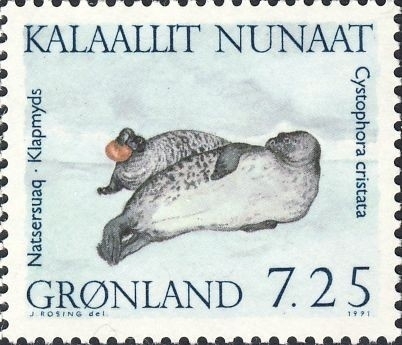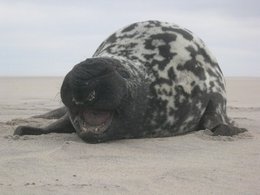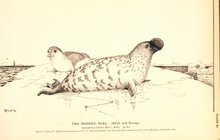Hooded seal
The Hooded seal, also known as Bladdernose seal (scientific name: Cystophora cristata), is one of nineteen species of marine mammals in the family of true seals. Together with the families of eared seals and walruses, True seals form the group of marine mammals known as pinnipeds.
The hooded seal derives its name from the males ability, when mating, excited, or threatened, to close one of his nostrils and inflate its trunk. The inflated trunk forms a crest or a hood on top of the head.
Contents
Physical Description
| Conservation Status |
|
Scientific Classification Kingdom: Animalia (Animals) |
The hooded seal has a black head and a dark clouded spotted pattern on grayish colored fur. Males are approximately 2.5 meters with body mass of approximately 400 kilograms, while females are slightly smaller. The most unusual physical characteristic of the hooded seal is the inflatable trunks of males. The trunk is a large flap that hangs in front of the head in front of the mouth. It can be inflated when the male is mating, excited, or threatened. The hooded seal also has large claws on its front flipper.
Distinguishing characteristics: medium size seal, male has inflatable red nasal sac, adult is mottled bluish-grey with a black face. Pups are white but quickly moult to a blue dorsal coat, with a dark face and white underbelly; hence, they are often called bluebacks.
Reproduction
The mating system of hooded seals is not well understood, but indications are that males practice sequential female-defense polygyny.
Hooded seal pups are born during March and April after a gestation period of 11.7 months, which may also include a period of four months when the fertilized egg is dormant and does not develop. Hooded seals usually give birth to one pup at a time. The pup weighs 15 kilograms at birth and is weaned after only four days of nursing due to the high fat content of the milk. The pups lack an embryonic coat at birth and are blue in color with light gray bellies and black faces. After a year, the pups become spotted like the adults.
Behavior
The most unusual behavior of the hooded seal is related to the males' trunks. When a male is mating, excited, or threated, the trunk is inflated. To accomplish this, the male closes one of his nostrils, resulting in the trunk blowing up to as large as twice the size of a football. The inflated trunk forms a crest or a hood on top of the head. This trunk begins to form in young males around 4 years of age and is finished developing at around 12 years. The size of the trunk depends on the body size of the individual, but the average capacity is 6.3 liters.
The hooded seal is mainly a solitary animal, but families are encountered during the reproductive season.
Distribution
Hooded seals are found throughout the northern part of the Atlantic Ocean near Labrador and northeastern Newfoundland, south to New England. Wandering individuals have been recorded from as far south as Puerto Rico and the Virgin Islands. Sightings have also been made in the Faroe Islands, Greenland, Norway and the United Kingdom.
Habitat
The hooded seal lives chiefly on large ice packs and in the deep waters of the Atlantic Ocean.
Food Habits
The hooded seal eats mainly deep water fish including redfish, Greenland turbot, herring, capelin, cod, halibut, and flounder. Its diet also includes shrimp, octopus, and mussels.
Conservation Status
While the total population of hooded seals is strong, the species has suffered a dramatic long-term decline in the northeast Atlantic Ocean where its numbers have dropped from over half a million to 70,000 (85-90%) it the past 40-60 years. The cause of this not known, but it seems to be continuing. Thus, the hooded Seal is classified ad Vulnerable.
Economic Importance for Humans
Hooded seals are mainly hunted for their spotted coats as well as the blue coats of the pups. Also, in some areas of the world the hooded seal is hunted for its meat and oil.
Further Reading
- Cystophora cristata (Erxleben, 1777) Encyclopedia of Life (accessed April 14, 2009)
- Cystophora cristata, Yoo, R., 1999, Animal Diversity Web (accessed April 14, 2009)
- Hooded Seal, Seal Conservation Society (accessed April 14, 2009)
- Cystophora cristata, IUCN Red List of Threatened Species (accessed April 14, 2009)
- The Pinnipeds: Seals, Sea Lions, and Walruses, Marianne Riedman, University of California Press, 1991 ISBN: 0520064984
- Encyclopedia of Marine Mammals, Bernd Wursig, Academic Press, 2002 ISBN: 0125513402
- Marine Mammal Research: Conservation beyond Crisis, edited by John E. Reynolds III, William F. Perrin, Randall R. Reeves, Suzanne Montgomery and Timothy J. Ragen, Johns Hopkins University Press, 2005 ISBN: 0801882559
- Walker's Mammals of the World, Ronald M. Nowak, Johns Hopkins University Press, 1999 ISBN: 0801857899
- Hooded Seal, MarineBio.org (accessed April 14, 2009)
- Erxleben, J.C.P., 1777. Systema regni animalis per classes, ordines, genera, species, varietas, cum synonymia et historia animalium. Classis I, Mammalia, 1:590. Wegand, Leipzig, 636 pp.
- Parker, Sybil P. "Hooded Seal." Grizmek's Encyclopedia of Mammals. 1990 ed.
- Cystophora cristata, by Kit M. Kovacs and D. M. Lavigne, The American Society of Mammalogists, June 16, 1986
- Wilson and Reeder's Mammal Species of the World third edition,




